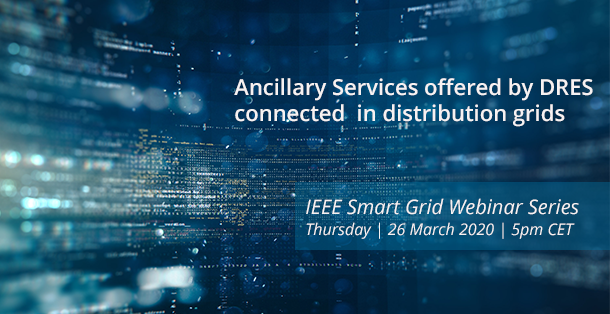
Webinar ‘Ancillary Services offered by DRES connected in distribution grids’
EASY-RES colleagues Charis Demoulias and Miloš Cvetković could snatch a spot in the Webinar series organized by IEEE Smart Grid.
What is the context of the Webinar?
The high proliferation of inverter-interfaced Distributed Renewable Energy Sources (DRES) at distribution grid level will gradually replace the conventional fuel-driven synchronous generators (SGs) at transmission system level. The inverter-interfaced DRES are mostly driven by variable-output RES such as PV or wind plants and for this reason are considered as non-dispatchable. There are DRES employing SGs directly connected to the grid which are mostly driven by biomass or small-hydro units, thereby considered as dispatchable. Although non-dispatchable, the inverter-interfaced DRES are highly controllable, thus able to provide a number of new services. DRES, particularly the inverter-interfaced ones, must urgently adopt a new more active role in the electricity networks by providing Ancillary Services (AS) similarly to the conventional SGs and even new ones within the distribution grids in order to keep the system stability and robustness. Such AS include: inertial response, active power ramp rate control, operation in frequency sensitive mode, voltage regulation, contribution to fault clearing and harmonic mitigation.
Part I of the Webinar took place on 26 March 2020, Part II of the Webinar is going to take place on 9 April 2020.
What is the focus of the Webinar?
This webinar will provide suggestions on (i) how to control the DRES inverters, so that they behave as controllable SGs able to provide the aforementioned AS in a unified way; (ii) methods to aggregate frequency related AS to be offered to the transmission system; (iii) methods on the measurement and quantification of various AS, so that they are transformed from system support functions into tradable AS; (iv) methods for testing the DRES inverters with respect to the new AS. The webinar will also present the obstacles posed by current grid codes, standards or market regulations for the introduction of the new AS and provide suggestions on lifting those obstacles. It is noted that batteries, although not a conventional type of RES, are included in this webinar, since they can provide a number of the aforementioned AS either by themselves or in combination with the non-dispatchable DRES.
Who should attend the Webinar?
DRES Manufacturers, Distribution System Operators, Policy makers, Transmission System Operators, electricity retailers, DRES Aggregators, Balancing Service Providers (BSP), independent DRES producers and their respective unions, National Regulatory Authorities, Standardization bodies, Energy communities, consultants and possibly market regulatory bodies. Academia and research institutions in the fields of DRES, power electronics, power systems and smart grid technologies.
How to join the Webinar Part I on 26 March 2020 or access the recording afterwards?
Please register here.
Who will present the Webinar?
Charis Demoulias (EASY-RES Project Coordinator) and Miloš Cvetković (EASY-RES Work Package 6 Leader) will lead the Webinar. Find their bios here.
How long is the Webinar going to take?
The duration of the Webinar will be 1 hour.
Is a replay of the Webinar of interest for you?
The replay of the Webinar will take place on Friday, 27 March 2020 at 9:00pm ET, and for sleepless Europeans on Saturday, 28 March 2020 at 3:00am CET.
Find the stream of the Webinar Part I here.
And after the Webinar Part I?
Please find here the interview of Charis and Milos who are answering questions which originated during the Webinar Part I from 26 March 2020.
Picture by Dmitriy Rybin on Shutterstock.
